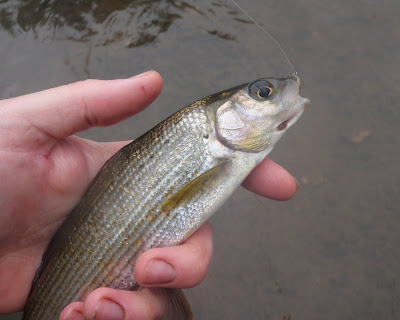
Success came fairly quickly as the leader tip darted forwards and a stuborn, out of season brownie fell to a bug trundled along the bottom. It parted company quickly and thankfully it had not thrashed about too much. Another few casts and the leader lifted again. This time a lift was met with that typical roll of a grayling, a flash of silver flank and some dogged pulling:

The river is literally full of life. The Rhyacophila larvae are a main-stay of food for grayling and trout. It's good practice to turn a few stones and check that your imitation matches the natural. It's also good to see the good health levels of the stream. These indicator species are vital early warning signs of problems.

There's alot of variation in the size of the food on offer. Here you see a Rhyacophila larva above a much smaller larvae. Remember, sometimes you can take fish on a #10; other times they demand a #20. A decent imitation fished through each run is likely to bring some success.

This small piece of submerged bark must have had several hundred specimens on it. The fish's larder!

... and a cased caddis showing itself. Note the green head:
 A useful imitation of the cased caddis:
A useful imitation of the cased caddis:Plenty of fish were willing to take. None of them huge, but on long, light rods, they give a good account of themselves:

A better handful:

The forecast was spot on too. The rain started to fall and the river started to colour a little more. Mind you, Spring is in the air and it's good to be on and in the water.

~Dave



No comments:
Post a Comment